
views
- Format your letter like a business letter, and start with a professional greeting.
- Include your name and as many details about the complaint as you can, including documents and witnesses.
- Write about what you’ve tried so far, and end the letter by stating a proposed solution.
- Follow up with HR after a few days or weeks for mediation or a resolution.
Harassment Complaint Letter

Define what workplace harassment is before you start. Identifying workplace harassment will help you formulate your letter. Sexual harassment is one form of workplace harassment, but it isn’t the only form. You can be harassed on the basis of sex, race, color, religion, national origin, disability, age, or genetic information. Consider the following behaviors, which might qualify as harassment: Derogatory remarks or slurs based on the protected characteristic Intimidation Threats and physical assaults Telling offensive jokes

Write down details about the harassment. Give Human Resources as much information as possible. Sit down and write down the following: Who harassed you and their relationship to you. You can be harassed by a supervisor or by a coworker. Also, the harassment can come from someone of the same sex as you. When each harassing act occurred—date, time, and location. Also write down what the person said or did, and how you responded. Who witnessed the harassment. Write down their names and job titles. What tangible evidence you have of the harassment. For example, you may have harassing emails, voice mails, or notes.
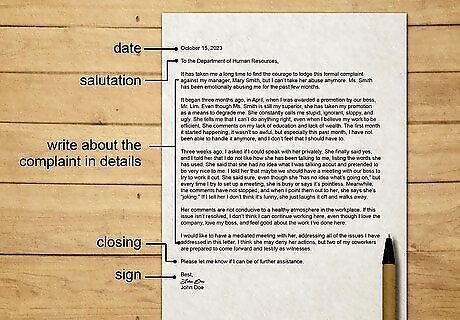
Format your letter like a business letter. If you know the name of the contact in Human Resources, then include that in the salutation. Call and ask if you don’t know.
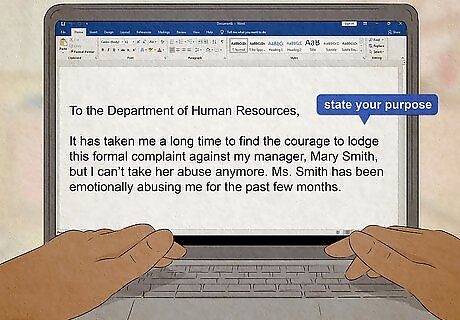
Introduce yourself and your purpose. In the first paragraph, give HR some idea why you are writing to them. For example, state that you want to lodge a complaint about harassment and identify your harasser.
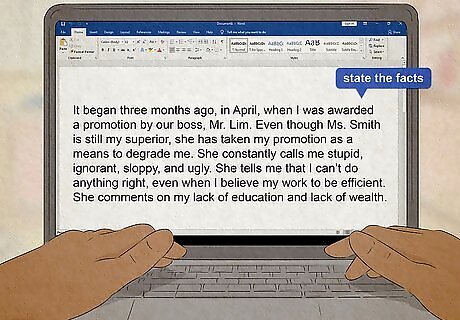
Lay out the facts of the harassment. Be clear and get to the point. Provide enough information that HR can see there is a harassment problem that needs investigation. Explain where and when the harassment occurred, as well as who witnessed it. Describe the incidents in chronological order, which is the easiest for people to understand. In some larger organizations, HR might not know everyone, such as a coworker. Identify who they are, e.g., “Jason Jones, who works in the cubicle next to me, saw our boss make the obscene gesture.” Stick to the facts. Don’t make any kind of allegation or charge that you can’t back up with proof, such as your written memories or a witness. For example, don’t speculate about your boss or coworker’s motivation for what they said or did, since there’s no way to prove that. EXPERT TIP Lily Zheng, MA Lily Zheng, MA Diversity, Equity & Inclusion Consultant Lily Zheng is a Diversity, Equity, and Inclusion Consultant and Executive Coach who works with organizations around the world to build more inclusive and innovative workplaces for all. Lily is the author of Gender Ambiguity in the Workplace: Transgender and Gender-Diverse Discrimination (2018) and The Ethical Sellout: Maintaining Your Integrity in the Age of Compromise (2019). Lily earned her MA in Sociology from Stanford University. Lily Zheng, MA Lily Zheng, MA Diversity, Equity & Inclusion Consultant Make sure the letter answers "who," "what," "where," and "when." Clearly lay out the problem and its impact on you and your work, along with any relevant information HR might need to know. Then, suggest a solution that will resolve the problem and its negative impact."
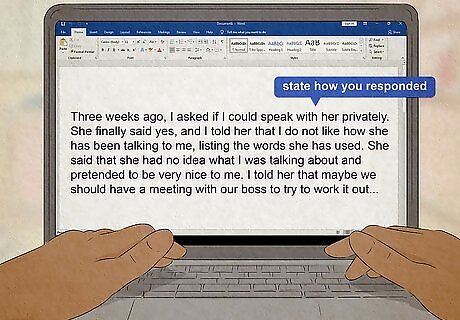
Explain how you responded to the situation. This is legally important. Harassment is only illegal if it is unwelcome. State what you did or said in response. For example, you might have told someone not to touch you. Also explain if you tried to resolve the issue. For example, you might have met with your harasser to ask them to stop making sexually-explicit jokes. Remember to explain how the harassment made you feel. For example, you might have had trouble working in a team with the person who was harassing you, which caused you to skip work or perform below your usual standards.
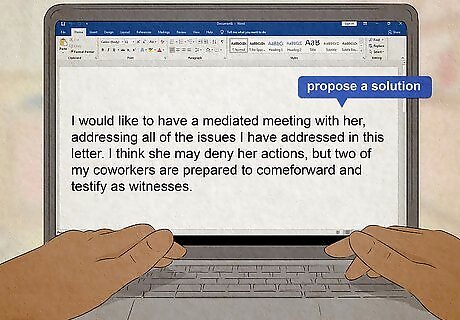
Propose a solution. At the end of the letter, state what you want from HR. For example, you might want to be transferred to a different department. You can also request that HR investigate your harasser and give them consequences. However, avoid telling HR to “fire” your harasser. That’s their judgment to make. Remember to end the letter by thanking HR for their time. Insert “Best” or “Sincerely,” and then sign the letter. EXPERT TIP Lily Zheng, MA Lily Zheng, MA Diversity, Equity & Inclusion Consultant Lily Zheng is a Diversity, Equity, and Inclusion Consultant and Executive Coach who works with organizations around the world to build more inclusive and innovative workplaces for all. Lily is the author of Gender Ambiguity in the Workplace: Transgender and Gender-Diverse Discrimination (2018) and The Ethical Sellout: Maintaining Your Integrity in the Age of Compromise (2019). Lily earned her MA in Sociology from Stanford University. Lily Zheng, MA Lily Zheng, MA Diversity, Equity & Inclusion Consultant Our Expert Agrees: To ensure that the resolution you suggest is appropriate, put yourself in the perspective of the decision-maker, and ask yourself, "Does this make sense?" and "What other options are available?"
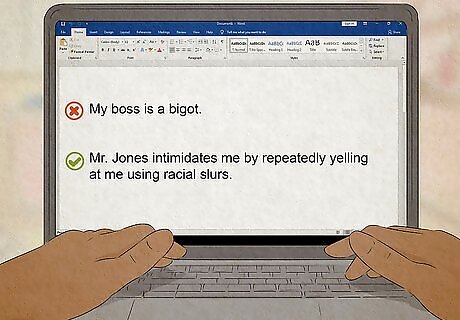
Avoid using offensive language. Although you may be angry, try not to show it. Using foul language can undermine your ability to get help. In fact, the person reading the letter might become angry at you instead, which is the opposite of what you want. Instead of writing, “I’m so pissed right now,” write “I am angry.” Instead of “my boss is a bigot,” write “Mr. Jones intimidates me by repeatedly yelling at me using racial slurs.”
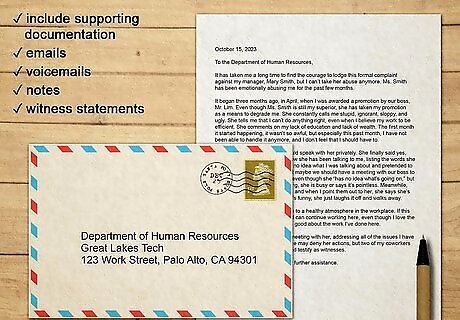
Send the letter to HR. After you sign your letter, make a copy before sending it. Also hold onto any supporting documentation, such as emails, voicemails, notes, or witness statements. You may need to share them if HR opens an investigation.
General Complaint Letter

Pinpoint exactly why you want to submit a complaint letter. There are many issues you should bring to the attention of Human Resources. For example, you might want to complain about the following: You haven’t been paid properly: your company might be withholding pay, not calculating it properly, etc. You have not received what you have been promised under your employment contract. Your boss or coworkers are bullying you. Some abuse doesn’t qualify as workplace harassment. Legally, harassment must be based on a protected characteristic, such as race, gender, religion, age, etc. Nevertheless, someone might bully you simply because they don’t like you. You are being discriminated against, either for race, religion, gender, or political beliefs.

Gather the facts about what happened. Imagine the HR employee who reads your letter. They might not know who you are or have any knowledge of what's been going on. For these reasons, fill your complaint letter with facts. Gather the following: What happened, when, and where. If you’ve been bullied, write down the details. Who is involved (your immediate supervisor, coworker, an employee in a different part of the organization, etc.) How you attempted to resolve the issue. Did you talk to a supervisor? Ask HR for help already? Write down the dates and the names of who you spoke with. Also, summarize any responses you received.
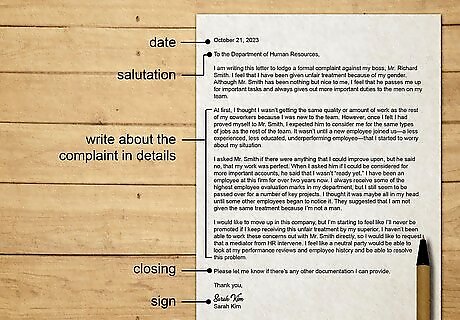
Set up your letter using a business format. Properly format your word processing document by choosing a legible font size and style (Times New Roman 12 point works well). Also use block paragraphing. Contact HR and ask who to address your letter to. Write a salutation like “Dear Mr. Marshall” or something equivalent.
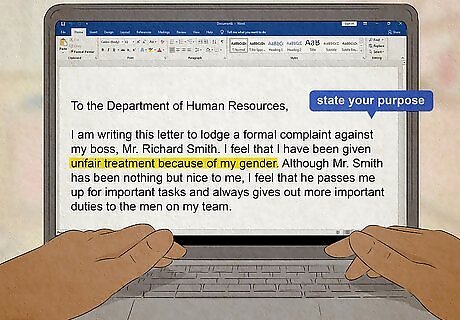
Get to the point quickly. State that you want to make a complaint and identify the substance of the complaint. If you work in a large organization, identify yourself as well. For example, begin with something like: “I am a data processing clerk in our accounting office. I’m writing to complain that my total pay has been inaccurate for 2 months now.”
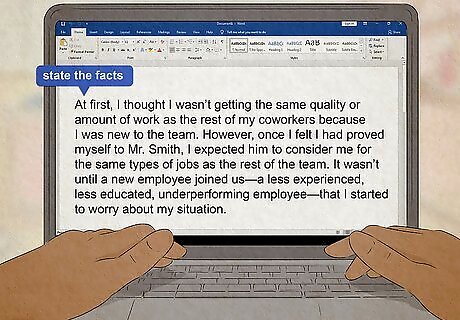
Provide details. Give the reader enough information so that they can effectively investigate. If you haven’t been paid properly, identify the pay periods. If you’re being bullied, provide a chronological discussion of the major bullying incidents. Write something like the following: “There have been 3 major bullying incidents” and then write “Additionally, there has been low-level bullying, which I am happy to discuss in person with you.”
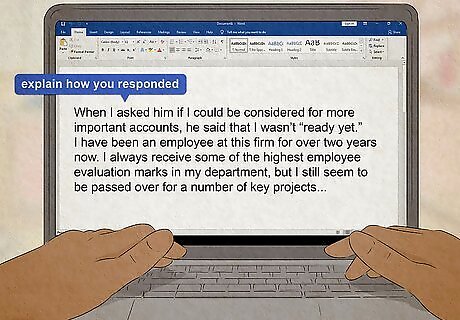
Explain how you have handled the issue. Let HR know what attempts you have made to fix the problem and why you are unsatisfied with the results. If you’ve spoken to a supervisor, state so. Remember to provide dates. For example, “On January 12, I told my supervisor, Larsa Chavez, about my pay being wrong. Although she said she would investigate, my pay hasn’t changed and she doesn’t seem too worried about it. We are now approaching the 2-month mark and I am still not being paid properly.” Also let HR know how you have been feeling. For example, if you are being bullied, briefly explain how it has affected your health. Identify if you had to take time off or had to see a doctor.
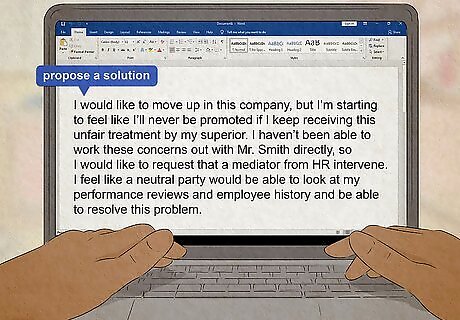
End the letter with a request for a resolution. Ask HR to investigate and to contact you if they have questions. Sign your letter beneath the word “Sincerely” and keep a copy of the letter for your records. If you don’t think HR has your phone number, include that as well.
Resolving the Issue

Meet with an HR investigator. Depending on the severity of your complaint, HR might appoint an investigator to gather more information. You may need to sit down for an interview. Also provide supporting documentation promptly. Although you may be told that the interview is confidential, expect many other people in the organization to know what you have written.

Participate in mediation if HR recommends it. Human Resources might have a mediation program you can use to resolve disputes. In mediation, you and the person you are having problems with will meet with the mediator, who is a neutral third party. The mediator isn’t a judge. However, they can help each side talk and listen to each other. The purpose of mediation is to resolve the dispute voluntarily so that each side can walk away feeling good. If the harassment has been severe, don’t feel compelled to mediate a dispute with your employer. Instead, find an attorney and discuss next steps. Your employer might offer “conciliation,” which is like mediation. However, the conciliator is more involved in decision-making than a mediator, who lets the parties decide on a proper resolution.

File a harassment charge with the EEOC if HR won’t investigate. The Equal Employment Opportunity Commission (EEOC) investigates claims of workplace harassment. You can file a complaint (“charge”) with them. You may also complain to a state agency that investigates harassment. Avoid delaying this step. You have 180 days from the date of the harassment to file a discrimination charge with the EEOC. Your state agency may give you more time. Generally, federal EEOC law covers most employers. But some smaller employers might only be covered by state law. If your employer has 15 or fewer employees, you may need to complain to your state agency.

Hire an attorney to escalate the situation beyond your workplace. You need expert assistance to protect your rights. A lawyer can help you if your employer retaliates against you, continues to harass you, or refuses to pay owed wages. Contact your local or state bar association and ask for a referral. Visit the American Bar Association to find your nearest bar association. Ask for an employment lawyer. When you call to set up a consultation, ask how much the lawyer charges. Prepare for your consultation by gathering helpful documents, such as a copy of your complaint letter to HR. At the consultation, you will discuss whether you have a legal case. Not all harassing conduct rises to the level of legal harassment. For example, 1 off-color joke probably doesn’t qualify.




















Comments
0 comment